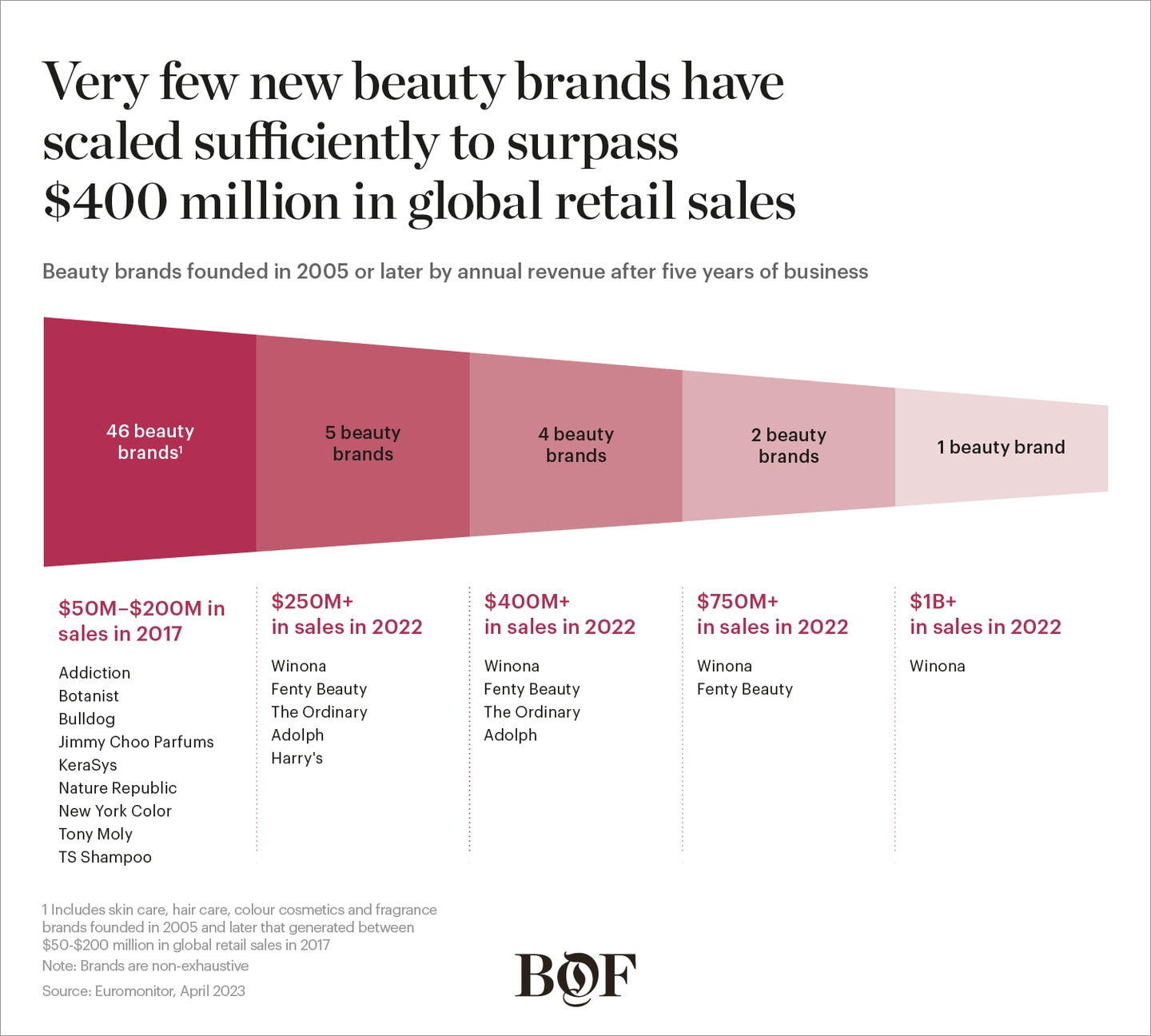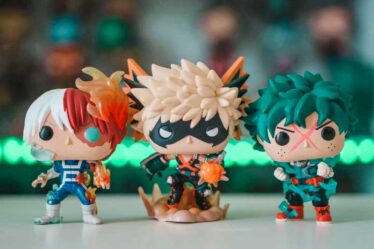
The first wave of digitally innovative independent brands burst onto the beauty scene in the early 2000s and disrupted an industry long dominated by conglomerates and brick-and-mortar retailers. To grab market share, these challengers used a combination of tactics to their advantage: direct-to-consumer selling, low-cost marketing, outsourced product development and a focus on underserved consumer groups to shake up beauty’s status quo.
But many of these challengers have been unable to build on their early momentum. Some of the buzziest brands of recent years haven’t grown much: in a McKinsey analysis of 46 brands that launched after 2005, each with global retail sales of between $50 million and $200 million in 2017, only four had surpassed $400 million in sales five years later.
One critical reason for the slowed momentum is that the market is now highly saturated with competition from all sides. Legacy brands have taken a page from the newcomers’ book, updating product portfolios and marketing, with considerably more capital. At the same time, indie brands are launching at a rapid clip. All this has created an even more challenging environment than when early disrupter brands got their start.
Tellingly, the four brands that have scaled beyond $400 million are based in the world’s largest beauty markets: Fenty Beauty and The Ordinary in North America, and Winona and Adolph in China. While Fenty Beauty and The Ordinary went global early in their lifecycles, Winona and Adolph have stayed focused on China. Adolph headed into the hair care market, where Western conglomerates have long had a strong presence, launching its prestige shampoos in 2013. Dermatology-focused Winona, founded in 2010, zeroed in on sensitive-skin products tailored to common ailments in China.

The beauty players that have defied growth challenges offer lessons for other brands on the critical steps to achieving scale: channel expansion across brick-and-mortar retail and online, and disciplined category expansion.
Mixing It Up
Most of the brands that exceeded the $400 million retail sales mark in McKinsey’s analysis significantly diversified their sales channels to grow their customer base. In the US market, for instance, they partnered with beauty retailers like Sephora or Ulta Beauty, online and offline.
There are a host of reasons why young brands need to recalibrate their channel mixes. Certainly, the pandemic played a role in amplifying digital opportunities as lockdowns essentially halted brick-and-mortar while spurring e-commerce. The case for a mix of both online and offline is now strong: McKinsey’s 2023 global consumer survey found that among respondents who buy beauty products online, 36 percent visit the retailer’s physical store, and 28 percent visit other physical stores, before making a purchase online. Customers want to see, test and smell beauty products before making purchases.
Meanwhile, finding the right retail partner has been a central part of expanding a brand’s reach. The physical and online footprints of multi-brand retailers — which in the US, for example, include beauty players like Sephora and Ulta Beauty, big box retailers like Target and department stores — are hard for many brands to match on their own. And the choice has been widening to include other beauty retailers like Bluemercury.
In recognition of this, brands that previously sold only through online direct-to-consumer channels have begun turning to multi-brand retailers to generate sales. The seeds were already being sewn pre-pandemic: for example, men’s grooming and skin care company Harry’s, which launched as an online pure play, forged short-term partnerships with J.Crew, Barneys and several barbershops before selling its products in Target, Boots and other retailers. “It gave us the conviction that people wanted to experience our brand in a retail environment,” co-founder and chief executive Jeff Raider told The Business of Fashion. The brand now generates more than $250 million in annual sales. More recently in 2023, Glossier, which also expects to exceed the $250 million annual sales threshold this year, entered Sephora as part of a new strategy to spur sales growth.
Controlling the Trajectory
Beauty upstarts have long known that finding and articulating their unique selling point can make or break their businesses. But today, getting it right is far more complex than it once was amid competition from a growing number of brands. Inclusive imagery, influencer partnerships and ingredients transparency are table stakes, not differentiators. Brands must offer shoppers a clear, unique value proposition, rather than playing copycat. For example, Winona identified white space in China, developing and marketing products in collaboration with dermatologists and other science and medical professionals, drawing on its hometown of the Yunnan province in southwestern China, which is known for its medicinal species of plants.
The international expansion timeline is also critical. For independent brands, pace of growth can be a challenge. Expand abroad too quickly and a brand risks spreading itself too thin and losing focus; grow too slowly and competitors might race ahead. In the case of US-based drugstore skin care brand CeraVe, it focused on growing domestically for 10 years and began selling internationally only after it was acquired in 2017 by L’Oréal. Yet even today, the brand generates most of its $1.3 billion in retail sales in North America. To be sure, brands that are headquartered in smaller markets will likely need to consider international expansion sooner.
The most successful emerging brands wait until they reach significant scale to expand their product range, focusing initially on only one main category. Makeup brand Fenty Beauty, for example, which now exceeds $500 million in sales, launched its first skin care items three years after its initial debut when it had reached over $400 million in annual retail sales. It leveraged its reputation for inclusive makeup shades for its first small expansion into genderless cleansers and serums, prioritising skin care items closest to its core makeup range. Similarly, Hourglass Cosmetics expanded its colour range into skin care with a limited assortment of products in 2014, 10 years after the brand was founded. It wasn’t until 2021, during the pandemic, that the brand further leaned into skin care by introducing new products to the portfolio.
The most successful emerging brands wait until they reach significant scale to expand their product range, focusing initially on only one main category.
Fuelling Growth
While securing investment from corporates or other investors makes it more likely that a brand will achieve scale, there are no guarantees. According to McKinsey research, out of a group of 78 recently founded global beauty brands that secured venture capital, private equity or another type of investment above $2 million between 2010 and 2015, 56 percent still generate less than $100 million in annual retail sales today, despite many having been acquired by corporates or financial investors — while 31 percent have gone out of business.
Arguably, some of the toughest decisions start-up founders and their executive leadership teams face as they aim to fund their transition from niche start-up to established player involve when and whether to sell a minority or majority stake in the business. The UK makeup brand Charlotte Tilbury, for instance, secured a minority investment from Sequoia Capital Partners in 2017 to widen distribution, including expansion into the Middle East, and saw sales grow by more than 30 percent year on year. In 2020, it sold a majority stake to privately owned fashion and fragrance conglomerate Puig to accelerate international and product expansion. Even with the reported $1 billion-plus deal with Puig, Tilbury holds a minority stake and is chairman, president and chief creative officer of the brand, with Demetra Pinsent, the brand’s original chief executive, remaining.
Even after a sale to a conglomerate or other large investor, challengers and their new parent companies need a plan to help ensure the original essence of the brand is not lost or overshadowed by other corporate priorities. When Procter & Gamble’s beauty division bought Mielle Organics at the start of 2023, Monique Rodriguez, a Black businesswoman who co-founded the US textured hair care brand with her husband Melvin in 2014, took to social media to assure followers that product formulations would not change. According to P&G at the time of the deal announcement, the brand, like others in its beauty division, would operate as an independent subsidiary, while focusing on expanding into underserved Black communities.
Independent brands will need to lean into innovation and tactically build out their channel strategies, international footprints and product lines to find themselves in a virtuous cycle of growth. In such a fast-moving sector, brands that fail to scale may find themselves running to standstill. Beauty is too crowded and competitive to support the plethora of brands coming to market over the long term. Ultimately, only a select group of newcomers will be able to establish themselves among the industry’s leading brands in the years to come. Yet incumbents cannot be complacent: while only a few challengers achieve significant scale, the sheer volume of independent brands in the industry is chipping away at the market share of larger players — which means the latter must continue to innovate and consider strategic mergers and acquisitions to stay ahead of the curve.
This article first appeared in The State of Fashion: Beauty report, co-published by BoF and McKinsey & Company.




